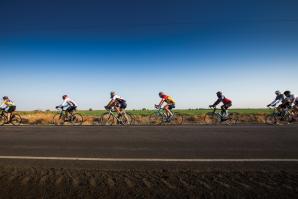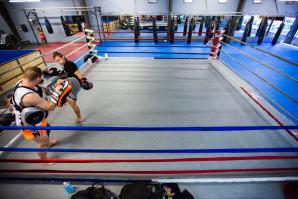When towns host competitive endurance events with names like Ironman, Spartan Beast and Tough Mudder, you can expect that contestants will leave plenty of footprints. They’ll also leave a lot of money, sometimes millions of dollars.
The nature of the events varies, emphasizing endurance, competition or a dirty good time. What they have in common is creating demand for hotel rooms, restaurant meals, athletic gear, nutritional supplements, construction materials and local advertising. While the national races tend to donate money to national charities, some contribute to local causes as well.
For the Ironman race slated for North Lake Tahoe next year, the total economic impact to the region is projected at $8 million to $15 million, says Andy Chapman, spokesman for the North Lake Tahoe Chamber of Commerce.
But no one has to wait for 2013 to work up a sweat and spend money. This month, the Tough Mudder comes to the Northstar California Resort near Lake Tahoe, one of about 20 U.S. stops the event will make this year.
Tough Mudder bills itself as a hardcore, 10- to 12-mile obstacle course designed by British Special Forces “to test your all-around strength, stamina, mental grit and camaraderie.” The obstacles go a bit beyond boot camp basics. The one called Arctic Enema, for instance, requires participants to swim through ice and under a wooden plank, and then pull themselves out before hypothermia sets in. There are more than two dozen other obstacles on the course.
“Last year it was at Squaw (Valley) and the amount of muddy people wandering in was staggering,” Chapman says.
The Tough Mudder is expected to draw 10,000 or more participants this year. Northstar can’t handle them all, Chapman notes, so some may stay in, say, Kings Beach and drive to Northstar.
Next month, Folsom plays host to the Merrell Down & Dirty National Mud and Obstacle Series Presented by Subaru. That race will send several thousand people over three miles of Folsom Lake State Recreation Area’s off-road trails — at night. The obstacles include the namesake crawl through the mud.
In November, Rancho Murieta’s Van Vleck Ranch will host an expected 6,000 runners — along with several thousand spectators — for the NorCal Spartan Beast.
Race founder Joe DeSena makes a point of calling it an obstacle race, not a “mud run,” which can be more of a mud party, he says. The Spartan has rules, judges and rankings, though the official description notes that “races are muddy, creative and extreme.”
The economic impact precedes the events. The Spartan will send in a crew of about 20 people a week before the race, and that group will grow to about 250 by the time the event starts. They all need hotel rooms and places to eat.
Local vendors will be tapped for firewood, straw, crushed stone and other materials to build obstacles.
“A lot of the time, we bring in a local excavator or someone who can do some heavy machinery for us,” race director Mike Morris says.
But that’s small potatoes compared to the impact contestants make. Not quite half of the racers and spectators come from out of town. Their length of stay averages 3.4 days, Morris says, and they pay an average daily hotel room rate of $130.
Next year’s Ironman race in North Lake Tahoe is anticipated to produce $8 million to $15 million for the local economy.
Out-of-towners spend an average of $478 per person, and the locals $156. And their clothing takes a beating.
“You’ll see 4,000 pairs of running shoes thrown away at the event,” DeSena says.
Sporting goods shops have taken note. It’s not unusual for events to cross-promote with Sports Authority, REI or similar retail chains.
The Muddy Buddy Run drives about 1,000 people through retail stores by making them the site for picking up race packets ahead of time, says Jamie Monroe, national series director for the Muddy Buddy races.
“They are not showing up to buy a bike,” Monroe says, “But they are buying water bottles and any other thing they think they might need the next day.”
Some stores will create special promotions such as register discounts that day.
REI gives its local managers some autonomy, says spokeswoman Bethany Hawley. They know their own territory best and can make the decisions about which organizations make good partners.
“They do a great job of providing assistance where they are able to and being pretty creative in how to promote it,” she says.
The Down & Dirty mud run hosts a catered burger bash, translating into business for local suppliers of burgers, fruit salad, chips and drinks, says Scott Roegner, special projects coordinator.
A Muddy Buddy course stretches four to eight miles on dirt trials, and not every city is well suited for obstacle events. It takes the right combination of population and open spaces.
“Depending on the property layout, you are looking at between 700 and 2,000 acres,” Monroe says. That makes state and national parks good candidates. But the events also need parking for thousands of people. Shuttle buses get expensive, so Muddy Buddy prefers sites with adjacent fields that can offer fairgrounds-style parking.
But a site can’t be too far out in the boonies, either. Most events want a location within an hour of a city, and 30 minutes is better. Some cities have the best of both worlds. Philadelphia was able to host a Down & Dirty race inside the city limits in Fairmount Park.
Most regions have limited options. Monroe is crossing his fingers for the Sept. 30 Muddy Buddy at Grant Regional Park on Mount Hamilton near San Jose. The park itself once canceled a Muddy Buddy because of rain.
“It was a disaster for us,” he says. “We’ve moved the date around to put it in a time period when it is less likely to rain.”
Recommended For You

#YOLO
The 7 best bike rides in Yolo County
Lovely scenery along gently rolling foothills has always made Yolo County an ideal place for cyclists, but who knew everyone took it so seriously?




